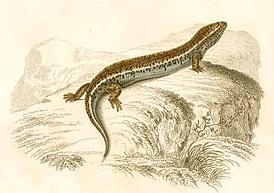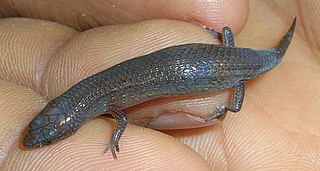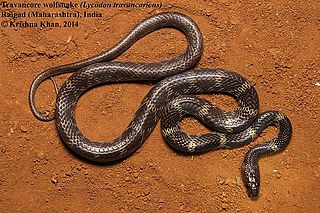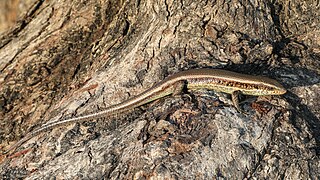
Chalcides is a genus of skinks.

Ristella is a genus of skinks, lizards in the family Scincidae. The genus is endemic to the Western Ghats of southwestern India. Member species are commonly known as cat skinks because of their retractile claws. This genus can be instantly identified by the presence of only four fingers in forelimbs in all the species. All the members look more or less similar, and are drab dark brown to blackish in colouration, with paler undersides. This poorly known group of lizards is diurnal, insectivorous, terrestrial to semi-fossorial in habits. They inhabit deep leaf-litter and grasslands in montane forests and rainforests.

The genus Sphenomorphus – vernacularly also known as the common skinks – currently serves as a "wastebin taxon" for numerous skinks. While most or all species presently placed here are probably rather close relatives, the genus as presently delimited is likely to be not monophyletic and is in need of review. Some species in this genus have been moved to Pinoyscincus.
Colonel Richard Henry Beddome was a British military officer and naturalist in India, who became chief conservator of the Madras Forest Department. In the mid-19th century, he extensively surveyed several remote and then-unexplored hill ranges in Sri Lanka and south India, including those in the Eastern Ghats such as Yelandur, Kollegal, Shevaroy Hills, Yelagiri, Nallamala Hills, Visakhapatnam hills, and the Western Ghats such as Nilgiri hills, Anaimalai hills, Agasthyamalai Hills and Kudremukh. He described many species of plants, amphibians, and reptiles from southern India and Sri Lanka, and several species from this region described by others bear his name.

Lycodon travancoricus, commonly known as the Travancore wolf snake, is a species of colubrid snake endemic to south India.

Cyrtodactylus collegalensis, also known as the Kollegal ground gecko or forest spotted gecko, is a species of gecko found in and around Mysore hills, at the junction of the Western Ghats and the Eastern Ghats, in South India. Recent taxonomic works and genetic studies revealed that the formerly-supposed genus is actually a subgenus of the widespread genus Cyrtodactylus. It is often confused with the forest spotted gecko.
Uropeltis dindigalensis, commonly known as the Dindigul uropeltis and the Sirumalai Hills earth snake, is a species of snake in the family Uropeltidae. The species is endemic to Sirumalai and surrounding hill ranges of the southern Eastern Ghats, in Dindigul district of Tamil Nadu state in South India.
Subdoluseps pruthi, known commonly as Pruthi's skink or Pruthi's supple skink, is a species of diurnal, terrestrial, insectivorous, lizard in the family Scincidae. The species is endemic to the southern part of the Eastern Ghats in South India. The species was first described based on the type specimen from Chitteri hills in Dharmapuri district of Tamil Nadu. Further surveys reveal the presence of similar-looking skinks in nearby hill ranges. Though described in 1977, the holotype was collected in 1929, and yet very little is known or has been published about this species.
Eutropis beddomei, commonly known as Beddome's mabuya or Beddome's skink, is a species of lizard in the family Scincidae. The species is native to India and Sri Lanka.

Ristella beddomii, commonly known as Beddome's cat skink and Beddome's ristella, is a species of skink, a lizard in the family Scincidae. The species is native to southwestern India.

Ristella rurkii, commonly known as Rurk's ristella, is a species of skink endemic to the Western Ghats of southern India. It is a small, insectivorous, diurnal skink found in shola grasslands and rainforests of hills ranges in parts of Tamil Nadu and Kerala states of India.

Ristella travancorica, commonly known as the Travancore cat skink or the Travancore ristella, is a species of skink endemic to the Western Ghats in India.

Kaestlea travancorica, also known as the Travancore ground skink or Barbour's ground skink, is a species of skink endemic to southern Western Ghats.

Sphenomorphus dussumieri, commonly known as Dussumier's forest skink and Dussumier's litter skink, is a species of skink, a lizard in the family Scincidae. The species is endemic to southern India.

Trachylepis is a skink genus in the subfamily Mabuyinae found mainly in Africa. Its members were formerly included in the "wastebin taxon" Mabuya, and for some time in Euprepis. As defined today, Trachylepis contains the clade of Afro-Malagasy mabuyas. The genus also contains a species from the Brazilian island of Fernando de Noronha, T. atlantica, and may occur in mainland South America with Trachylepis tschudii and Trachylepis maculata, both poorly known and enigmatic. The ancestors of T. atlantica are believed to have rafted across the Atlantic from Africa during the last 9 million years.

Eutropis is a genus of skinks belonging to the subfamily Mabuyinae. For long, this genus was included in the "wastebin taxon" Mabuya; it contains the Asian mabuyas. They often share their habitat with the related common skinks (Sphenomorphus), but they do not compete significantly as their ecological niches differ. This genus also contains the only member of the subfamily to occur in Australasia, the many-lined sun skink, whose wide range includes New Guinea.

The forest spotted gecko or Erode ground gecko is a species of gecko that is endemic to hills of South India, in parts of Eastern Ghats and Western Ghats. It was first described from hills near Erode in Tamil Nadu in 1870. Subsequently, this species was thought to be similar to Cyrtodactylus collegalensis, but recent studies have confirmed that they are distinct. This species has been sighted in hills around Coimbatore, Tirupur and Erode, in parts of the Eastern Ghats in Tamil Nadu.

Uropeltis madurensis, also known commonly as the Madura earth snake and the Madurai shieldtail, is an endangered species of small, fossorial, nonvenomous snake of the family Uropeltidae. The species is endemic to the Western Ghats of South India.

Kaestlea beddomii, also known as Beddome's ground skink, is a species of lizard in the family Scincidae. The species is endemic to the Western Ghats of India.














